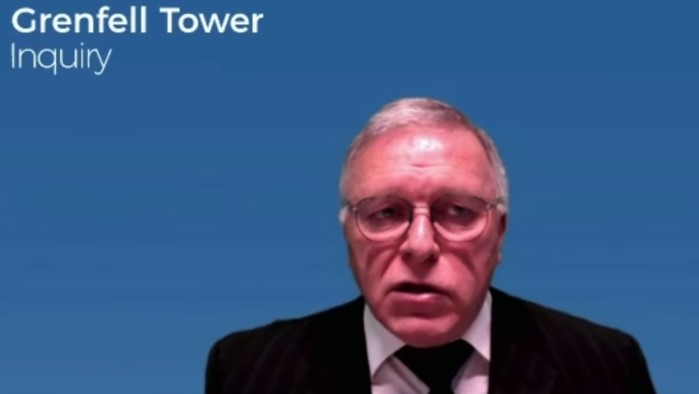
The BRE certification scheme manager for passive fire protection who oversaw Celotex’s BS 8414 test of its RS 5000 insulation has admitted that not including a magnesium oxide board to slow the spread of fire on the test report was a “fundamental omission”.
Giving evidence to the Grenfell Tower Inquiry yesterday (3 March), Tony Baker was asked about the test report produced following the May 2014 test of Celotex’s rig.
The rig passed thanks to the presence of a system that at certain levels (adjacent to the Lamatherm fire barrier and at the top of the rig) used an 8mm Marley Eternit cladding panel, immediately behind which was a 6mm magnesium oxide board. 12mm Marley Eternit cladding panels were used on the remainder of the rig.
However, the presence of the magnesium oxide was not mentioned in the BRE test report, and former Celotex product manager Jonathan Roper has claimed that the rig was “overengineered” to achieve a pass, after Celotex RS 5000 failed its first test in February 2014. Celotex attempted to conceal the presence of magnesium oxide in its marketing material once it had obtained a pass, according to Roper’s evidence.
The magnesium oxide board had been placed behind two ruby-coloured cement fibre panels, while the rest of the rig was covered in white panels, the Inquiry heard.
Baker was asked if it occurred to him while looking through illustrations in the test report that the boards in the area where they had been red were white following the conclusion of the test.
Counsel to the Inquiry Kate Grange QC asked Baker: “Didn’t it occur to you, when you were looking through these figures, that the board in this area had been read but was now white, in the figures showing the dismantling of the rig?”
Baker replied: “It should have done, but clearly it didn’t.”
Grange asked: “That should have alerted you to the fact that this was a different board or there was an additional board in those areas, shouldn’t it?”
Baker agreed that it should have done and that in hindsight it was a “very basic error” in the report. He said: “I don’t know how I’ve made a fundamental omission – error such as that.”
Baker said he recalled discussing the different colours on the rig with colleagues but only in general terms.
Baker’s colleagues at the time of the test, Philip Clark and Stephen Howard, have both denied knowing that the magnesium oxide board was present on the test rig.
Baker said: “If we were aware that they were there, we would have included it in the detail of the report, irrelevant of whether they may or may not have made any difference.”
Asked why there was no reference to magnesium oxide board in the test report, despite photographs showing its presence, Baker said: “I can’t explain that. Obviously the test report has been to the client as well and they haven’t highlighted the issue. I would expect us to pick it up and I would also expect the client to pick it up as well. But it would seem there was a concerted effort to hide it from us, although from the photo (18) there, obviously it’s not hidden well.”
Asked what made him say there was a “concerted effort” to hide details from BRE, Baker said: “Just having read their previous witness statements.”
The Inquiry continues.










